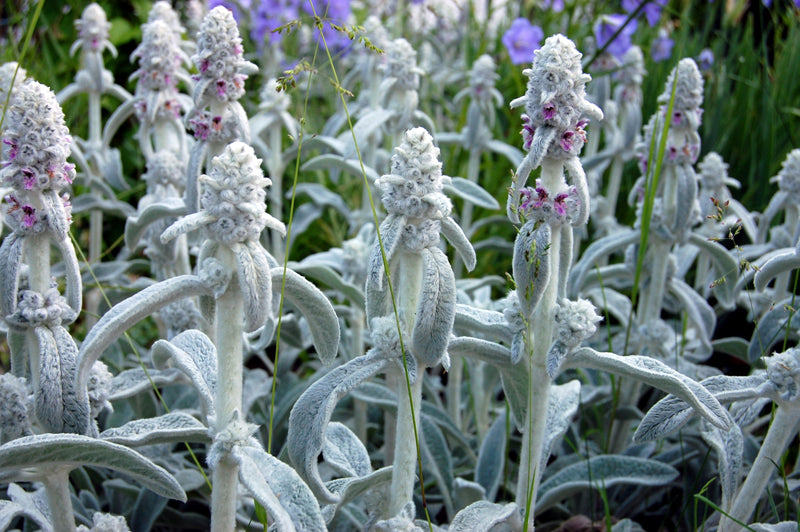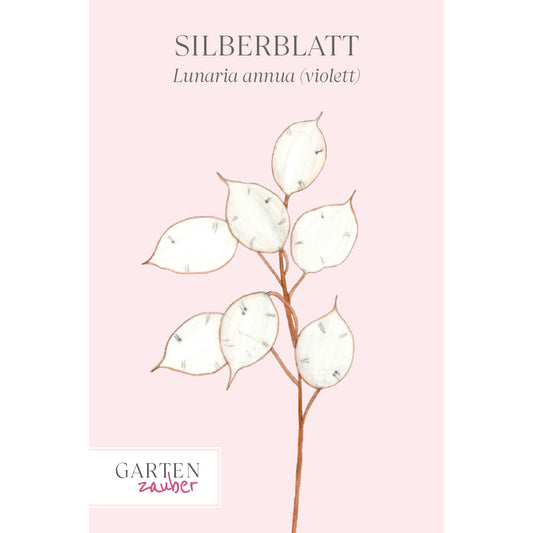Silver tones in the garden
They are the color all-rounders among perennials – plants with silvery leaves or flowers. They adapt to other plants, mediate, connect, and blend harmoniously into a planting. In both architecture and gardens, a certain trend toward simplicity, reduced material choices, and the colors gray and white can be observed. Perennials with their silvery shades can be used appropriately in these settings. We interviewed perennial gardener André Stade about which plants are particularly recommended and what you should keep in mind.

The effect of colors – indication of location
"Silver tones are mediating colors. They make neighboring colors appear brighter," says Stade. Plants that don't actually harmonize in terms of color can be separated by silvery plants, thus ensuring better color harmony in the bed. Silvery-white tones complement pink, lilac, and navy blue particularly well," says the expert. When choosing a location, the appearance of the plant says a lot about its needs. Silvery foliage indicates that the plants thrive in sunny locations and also tolerate drought very well. The plants protect themselves from sunlight with fine hairs and a thin layer of wax that makes the leaves appear silvery. "Many plants with silvery foliage come to us from warmer climates. They should therefore be planted in sunny locations," explains Stade. Another thing almost all of them have in common is the importance of a well-drained substrate so that excess moisture can drain away in winter and the plants survive the cold season well.
Leaf structures in silver with noble diamonds and co.
"There are many perennials that have a 'silver look,'" Stade enthuses. "Personally, I like to use southernwood (Artemisia) in the garden." These mostly highly aromatic plants have diverse appearances and a wide range of leaves at different heights. The small variety Artemisia schmidtiana Nana or the cushioned felt rue (Artemisia stelleriana 'Mori') are particularly well-suited for sunny borders. If you want to fill a larger area and have enough space, the variety Artemisia ludoviciana 'Valerie Finnis' is a good choice. This attractive southernwood species grows 60 cm tall and spreads out vigorously. A silver plant well-known in English gardens is Artemisia arborescens 'Powis Castle'. "Protect the 100 cm tall plant with a brushwood covering in winter and cut it back in spring," recommends Stade, "then you'll enjoy it for a long time." The leaves of Woolly Yam (Stachys byzantina) resemble rabbit ears. They are velvety soft. The plants prefer a sunny location and well-drained soil. The perennial expert notes that shallow-growing selections like Stachys byzantina 'Silky Fleece' make a wonderful ground cover, with their diverse flowers.

Silver leaf - Lunaria annua (purple)
Variety description:
The purple silver leaf is a fascinating plant that immediately catches the eye with its striking coloring and elegant appearance. Its unique color and structure make the purple silver leaf a versatile element in floral compositions, adding sophistication and style.
Details:
Sowing indoors/greenhouse: April to March
Sowing outdoors: October to March
Germination time: 28 days at 16-18°C
Sowing depth: approx. 2-3 cm, cold germinator!
Height: approx. 90 cm
Planting distance: 40 cm
Flower size: <5 cm
Flowering time: April to June
Soil: humus, moist
Fertilization: little organic fertilizer
Location: Partial shade
Water consumption: normal
Growing tips:
The seeds require a period of cold weather to germinate successfully. Mix the seeds with moist seed medium and place them in plastic bags. Due to the bags' watertightness, additional humidification is usually not necessary. Place the container with the seeds in a warm and humid environment (approximately +20°C) for the first 2-4 weeks, then place it in the refrigerator or another cool location with temperatures between 0 and 5 degrees Celsius. The duration varies depending on the plant species, but is usually several weeks to months.
After the cold period, the seeds need warmer conditions to encourage germination, so keep the substrate moist. Check the seeds regularly (ideally once a week), and once germination begins, sow the germinated seeds as usual in pots or suitable soil.
Alternatively, sowing can be done in the garden in the fall. Germination will then occur in the spring.
Use:
cut flower
dried flower
Insect pasture
Bag contents:
Approx. 150 seeds
Store in a cool, dry place.
Noble flowers in silver and white
Plants with white or silver flowers appear particularly elegant. The flower shapes range from flat, spherical, candle-shaped, or star-shaped. Globe thistles (Echinops) fit particularly well into the silver scheme. The classic variety is Echinops sphaerocephalus 'Arctic Glow', with white flowers and silvery leaves. These robust thistles thrive in warm, sunny borders and embankments. Many perennials now have white selections. "A great perennial is the white-flowering perennial sage (Salvia nemorosa 'Adrian'). Pruning after the first bloom will encourage 'Adrian' to bloom again," the perennial gardener regularly explains to his customers. There are also white-flowering varieties of purple coneflower (Echinacea), such as Echinacea purpurea 'Alba', which grows to 70 cm tall and is a fantastic butterfly magnet in late summer. The tall stonecrop (Sedum spectabile 'Stardust') also boasts white flowers. It grows 30 to 40 cm tall and its dry blossoms provide a decorative display in winter. Catmints (Nepeta) are very popular as hardy edging plants. The Nepeta x faasenii 'Snowflake' variety also offers white-flowering alternatives for the garden. They display their white blossoms above gray foliage from June to September.
It's the combination that makes it!
Silvery plants thrive on contrast with other colors. "I particularly like using silvery plants together with blue- or violet-flowering perennials," explains Stade. An example of a bed in this color combination with a particularly long bloom period in summer is the mixture of silver-leaved pearl daisies (Anaphalis triplinervis) with blue-flowering sage (Salvia nemorosa 'Blauhügel') and blue-flowering asters (Kalimeris incisa 'Blue Star'). All three impress with their long bloom periods. These complement each other well with gray-leaved catmints (Nepeta), which also boast a long-lasting blue bloom, and the scented nettle (Agastache x rugosa 'Blue Fortune') with its attractive flower candles. A great plant for the background of the planting presented here is the candelabra speedwell (Veronicastrum virginicum). The 'Diana' variety features white flowers, while 'Fascination' boasts reddish-violet candle-shaped inflorescences reaching 150 cm in height. "I also find gray-leaved cranesbill varieties suitable, such as the Caucasian cranesbill (Geranium renardii 'Terre Franche'), which impresses with its slightly grayish foliage and blue flowers," says Stade.

Tone-on-tone – aristocratically noble
Those who appreciate particularly elegant designs will find numerous examples in many English gardens. The "White Garden" in the gardens of Sissighurst, for example, is world-famous. Visitors can find inspiration here for creating elegant flowerbeds using white and silver plants. The gradation of planting and the coordination of flowering times are impressive. It is therefore important to know the exact height of the perennials so that the planting increases from front to back and the flowering times are appropriate. In the "Silver Summer" perennial mix, the perennial gardeners capture the silver shimmer effect and offer a long-term tested combination of different perennials for sunny, dry locations. At www.stauden.de you will also find other tried-and-tested mixes and ideas for your garden.
TEXT: GMH





































































































